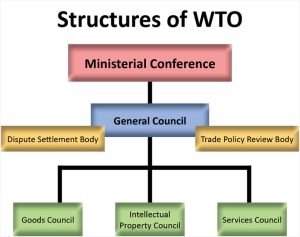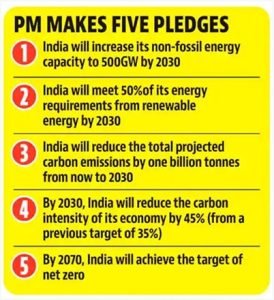WTO
It is an intergovernmental organisation that regulates and facilitates international trade. Marrakesh Agreement (1994) replaced General Agreement on Tariffs and Trade (GATT) that was established in 1948. WTO began operations on 1st January, 1995.
GATT was established for substantial reduction of tariffs and other trade barriers and the elimination of preferences, on a reciprocal and mutually advantageous basis. Its history can be traced to Bretton Woods Conference.

- Ministerial Conference is the highest authority of WTO. Representatives of all WTO members together form the Ministerial Conference. MC must meet at least every two years.
- General Council has representatives (usually ambassadors or equivalent) from all member governments and has the authority to act on behalf of the ministerial conference which only meets about every two years.
- Dispute Settlement Body: To oversee the dispute settlement procedures.
- Trade Policy Review Body: To conduct regular reviews of the trade policies of individual WTO members.
Dispute settlement Mechanism in WTO
The Dispute Settlement Body consists of a Chairman and representatives of all WTO members (usually government representatives). When the parties are not satisfied with the decision of the panel report, then either of the parties may appeal to the Appellate Body. The Appellate body consists of seven persons. But only three of them shall serve in one case.
The United States (US) has blocked all appointments to the WTO Appellate Body (AB) since 2017, citing certain procedural and substantive issues that need resolution. Currently, the AB is dysfunctional.
Food Fortification
Fortification is the practice of increasing the content of an essential micronutrient, i.e. vitamins and minerals (including trace elements) in a food item to improve the nutritional quality of the food supply and provide a public health benefit with minimal health risk.
Food Fortification can be divided into 3 –
- Commercial and Industrial Fortification
- Biofortification
- Home Fortification
While food fortification has been a common practice in developed economies, developing and underdeveloped countries are yet to take full-fledged advantage of these programmes. Iodisation of salt is a relatively common example of food fortification. FSSAI’s report suggest that over 70% of India’s population consumes less than half the daily recommended dietary allowance of micronutrients.
The World Health Organization recommends large-scale food fortification as a powerful evidence-informed and cost-effective intervention to fight vitamin and mineral deficiencies, including iodine deficiency disorders, anaemia, and iron deficiency, among others.
In 2016, FSSAI operationalized the Food Safety and Standards (Fortification of Foods) Regulations, 2016 for fortifying staples namely Wheat Flour and Rice (with Iron, Vitamin B12, and Folic Acid), Milk and Edible Oil (with Vitamins A and D) and Double Fortified Salt (with Iodine and Iron) to reduce the high burden of micronutrient malnutrition in India.

The ‘+F’ logo has been notified to identify fortified foods which were developed by Food Fortification Resource Centre.
The Centre also issued new mandates to use fortified staples in safety net programs, such as double fortified salt (DFS) and fortified edible oil through mid-day meal (MDM) and Integrated Child Development Schemes (ICDS).
India’s NDC

PM of India made 5 pledges at COP 26 held at Glasgow.

Paris Agreement on Climate Change
- It is a legally binding global agreement under the United Nations Framework Convention on Climate Change (UNFCCC) that was adopted in 2015. It was adopted in UNFCCC COP21.
- It aims to combat climate change and limit global warming to well below 2 degree C above pre-industrial levels, with an ambition to limit warming to 1.5-degree C.
- It replaced the Kyoto Protocol which was an earlier agreement to deal with climate change.
- Under the Paris Agreement, each country is required to submit and update their Nationally Determined Contributions every 5 years, outlining their plans for reducing greenhouse gas emissions and adapting to climate change.
